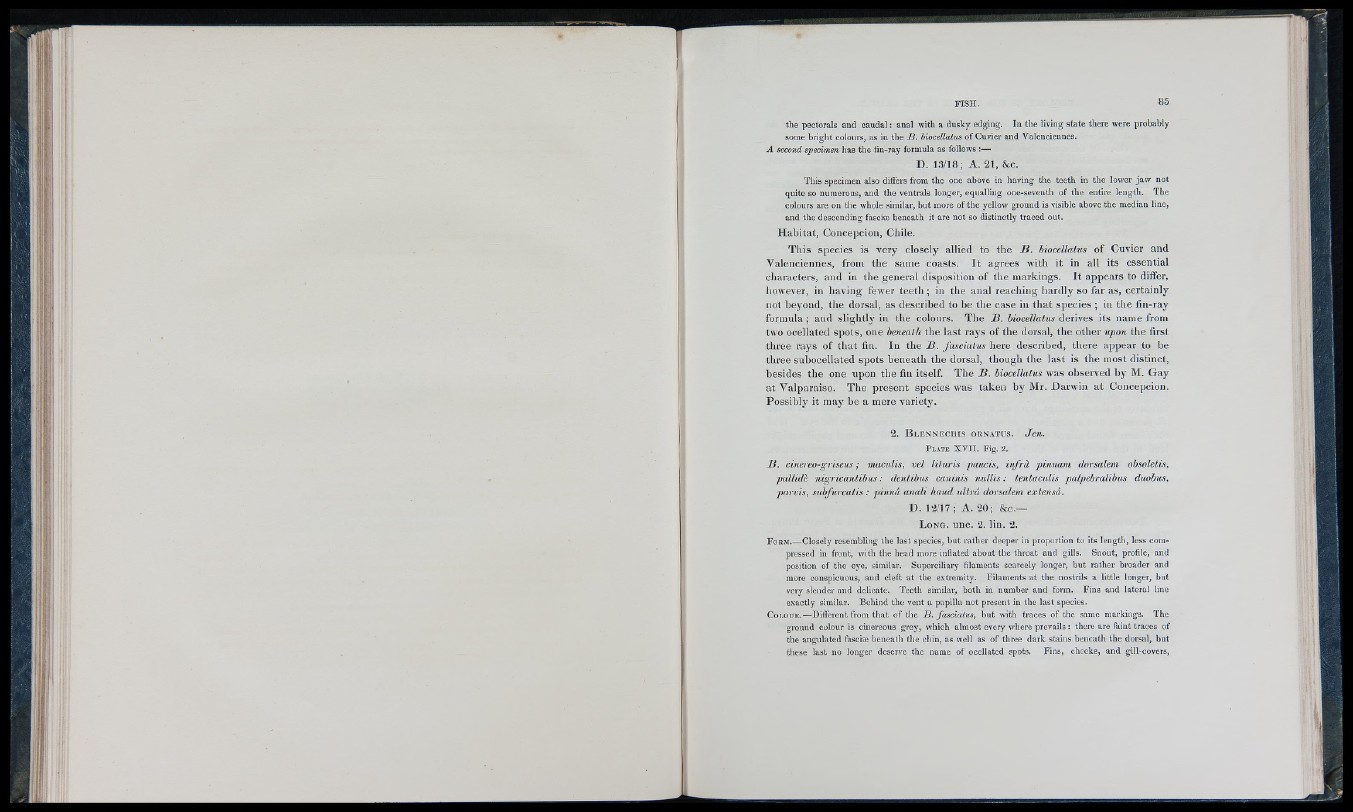
the pectorals and caudal : anal with a dusky edging. In the living state there were probably
some bright colours, as in the B . iiocellatus of Cuvier and Valenciennes.
A second specimen has the fin-ray formula as follows :—
D. 13/18; A. 21, &c.
This specimen also differs from the one above in having the teeth in the lower jaw not
quite so numerous, and the ventrals longer, equalling one-seventh of the entire length. The
colours are on the whole similar, but more of the yellow ground is visible above the median line,
and the descending fasciæ beneath it are not so distinctly traced out.
H abitat, Concepcion, Chile.
T his species is very closely allied to the B . Uocellatus of Cuvier and
Valenciennes, from the same coasts. It agrees with it in all its essential
characters, and in the general disposition of the markings. It appears to differ,
however, in having fewer teeth ; in the anal reaching hardly so far as, certainly
not beyond, the dorsal, as described to be the case in that species ; in the fin-ray
formula ; and slightly in the colours. The B . biocellatus derives its name from
two ocellated spots, one beneath the last rays of the dorsal, the other upon the first
three rays of that fin. In the B . fasciatus here described, there appear to be
three subocellated spots beneath the dorsal, though the last is the most distinct,
besides the one upon the fin itself. The B . biocellatus was observed by M. Gay
at Valparaiso. The present species was taken by Mr. Darwin at Concepcion.
Possibly it may be a mere variety.
2 . B l e n n e c h is o r n a t u s . Jen.
P l a t e X V II. Fig. 2 .
B . cinereo-griseus ; macnlis, vel lituris paucis, infrà pinnam dorsalem obsoletis,
pallidè nigricantibiis : dentibus caninis nullis : tentaculis palpebralibus duobus,
parvis, subfurcatis : pinnâ anali haud xdtrâ dorsalem extensâ.
D. 12/17 ; A. 20; &c.-—
L o n g . u n c . 2 . lin . 2.
F orm.— Closely resembling the last species, but rather deeper in proportion to its length, less compressed
in front, with the head more inflated about the throat and gills. Snout, profile, and
position of the eye, similar. Superciliary filaments scarcely longer, but rather broader and
more conspicuous, and cleft at the extremity. Filaments a t the nostrils a little longer, but
very slender and delicate. Teeth similar, both in number and form. Fins and lateral line
exactly similar. B ehind the vent a papilla not present in the last species.
C o lo u r.— Different from th a t of the B . fasciatus, but with traces of the same markings. The
ground colour is cinereous grey, which almost every where prevails : there are faint traces of
the angulated fasciæ beneath the chin, as well as of three dark stains beneath the dorsal, but
these last no longer deserve the name of ocellated spots. Fins, cheeks, and gill-covers,